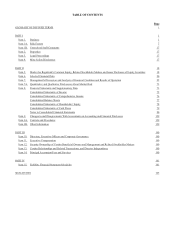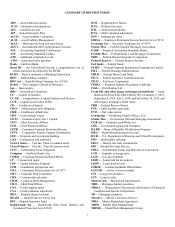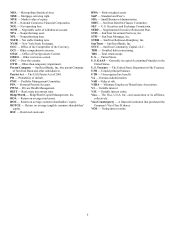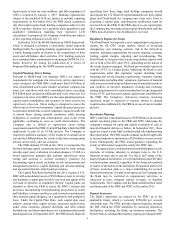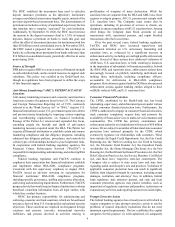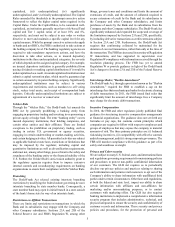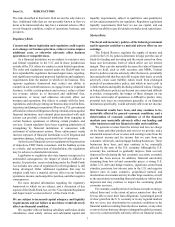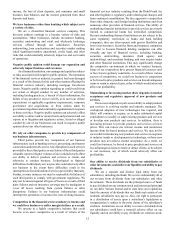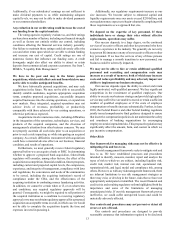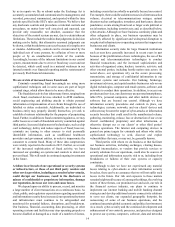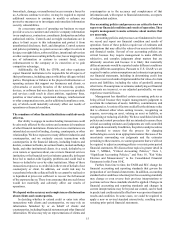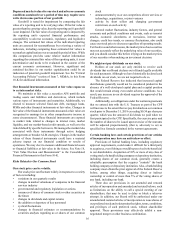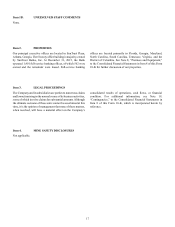SunTrust 2015 Annual Report Download - page 36
Download and view the complete annual report
Please find page 36 of the 2015 SunTrust annual report below. You can navigate through the pages in the report by either clicking on the pages listed below, or by using the keyword search tool below to find specific information within the annual report.8
and condition. Also, adverse economic conditions in Europe or
other markets may have a contagion effect, thereby impacting
us or our clients in the U.S.
Further, if unemployment levels increase or if home prices
decrease, we would expect to incur higher charge-offs and
provision expense from increases in our allowance for credit
losses. These conditions may adversely affect not only consumer
loan performance but also C&I and CRE loans, especially for
those businesses that rely on the health of industries or properties
that may suffer from deteriorating economic conditions. The
ability of these borrowers to repay their loans may be reduced,
causing us to incur higher credit losses.
A deterioration in business and economic conditions may
also erode consumer and investor confidence levels and/or result
in a lower demand for loans by creditworthy customers,
potentially reducing our interest income. It also could adversely
affect financial results for our fee-based businesses, including
our wealth management, investment advisory, trading, and
investment banking businesses. We earn fee income from
managing assets for others and providing brokerage and other
investment advisory and wealth management services. Because
investment management fees are often based on the value of
assets under management, a decrease in the market prices of
those assets could reduce our fee income. Changes in stock
market prices could affect the trading activity of investors,
reducing commissions and other fees we earn from our brokerage
business. Poor economic conditions and volatile or unstable
financial markets also can adversely affect our capital markets-
related businesses.
Changes in market interest rates or capital markets could
adversely affect our revenue and expenses, the value of assets
and obligations, and the availability and cost of capital and
liquidity.
Market risk refers to potential losses arising from changes
in interest rates, foreign exchange rates, equity prices,
commodity prices, and other relevant market rates or prices.
Interest rate risk, defined as the exposure of net interest income
and MVE to adverse movements in interest rates, is our primary
market risk, and mainly arises from the nature of the loans on
our balance sheet. We are also exposed to market risk in our
trading instruments, AFS investment portfolio, MSRs, loan
warehouse and pipeline, and debt and brokered deposits
measured at fair value. ALCO meets regularly and is responsible
for reviewing our open positions and establishing policies to
monitor and limit exposure to market risk. The policies
established by ALCO are reviewed and approved by our Board.
See additional discussion of changes in market interest rates in
the "Market Risk Management” section of Item 7, MD&A, in
this Form 10-K.
Given our business mix, and the fact that most of our assets
and liabilities are financial in nature, we tend to be sensitive to
market interest rate movements and the performance of the
financial markets. In addition to the impact of the general
economy, changes in interest rates or in valuations in the debt or
equity markets could directly impact us in one or more of the
following ways:
• The yield on earning assets and rates paid on interest-
bearing liabilities may change in disproportionate ways;
• The value of certain on-balance sheet and off-balance
sheet financial instruments that we hold could decline;
• The value of our pension plan assets could decline,
thereby potentially requiring us to further fund the plan;
or
• To the extent we access capital markets to raise funds to
support our business, such changes could affect the cost of
such funds or the ability to raise such funds.
Our net interest income is the interest we earn on loans, debt
securities, and other assets we hold less the interest we pay on
our deposits, long-term and short-term debt, and other liabilities.
Net interest income is a function of both our net interest margin
(the difference between the yield we earn on our earning assets
and the interest rate we pay for deposits and our other sources
of funding) and the amount of earning assets we hold. Changes
in either our net interest margin or the amount of earning assets
we hold could affect our net interest income and our earnings.
Changes in interest rates can affect our net interest margin.
Although the yield we earn on our assets and our funding costs
tend to move in the same direction in response to changes in
interest rates, one can rise or fall faster than the other, causing
our net interest margin to expand or contract. When interest rates
rise, our funding costs may rise faster than the yield we earn on
our assets, causing our net interest margin to contract.
The amount and type of earning assets we hold can affect
our yield and net interest margin. We hold earning assets in the
form of loans and investment securities, among other assets. As
noted above, if economic conditions deteriorate, we may see
lower demand for loans by creditworthy customers, reducing our
interest income. In addition, we may invest in lower yielding
investment securities for a variety of reasons.
Changes in the slope of the “yield curve,” or the spread
between short-term and long-term interest rates, could also
reduce our net interest margin. Normally, the yield curve is
upward sloping, meaning short-term rates are lower than long-
term rates. The interest we earn on our assets and our costs to
fund those assets may be affected by changes in market interest
rates, changes in the slope of the yield curve, and our cost of
funding. This could lower our net interest margin and our net
interest income. We discuss these topics in greater detail in the
"Enterprise Risk Management" section of Item 7, MD&A, in this
Form 10-K.
We assess our interest rate risk by estimating the effect on
our earnings under various scenarios that differ based on
assumptions about the direction, magnitude, and speed of interest
rate changes and the slope of the yield curve. We hedge some of
that interest rate risk with interest rate derivatives.
We may not hedge all of our interest rate risk. There is always
the risk that changes in interest rates could reduce our net interest
income and our earnings in material amounts, especially if actual
conditions turn out to be materially different than what we
assumed. For example, if interest rates rise or fall faster than we
assumed or the slope of the yield curve changes, we may
experience net interest margin compression and/or incur
significant valuation losses on debt securities we hold as
investments. To reduce our interest rate risk, we may rebalance
our investment and loan portfolios, refinance our debt, and take
other strategic actions. We may incur losses when we take such
actions. For additional information, see the “Enterprise Risk


